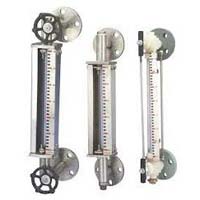
electronic gauges
Get Price Quote
Restricting to the pre-defined quality parameters, we make sure that the offered array of products is as per the stated norms. In order to ensure zero damage during transit, we have adopted modern facility for meticulously packaging our offerings. And, we also ensure that the used material is of high quality.

Pressure Gauges
Get Price Quote
When selecting a pressure gauge, it is important to consider the following factors to ensure safety and accuracy: 1. Pressure fluid composition 2. Pressure fluid temperature 3. Ambient conditions 4. Pressure range 5. Conditions affecting wear of the system 6. Method of mounting 7. Required accuracy 1. Pressure fluid composition Since the sensing element of a pressure gauge may be exposed directly to the measured medium, consider the characteristics of this medium. It may be corrosive, it may solidify at various temperatures or it may contain solids that will leave deposits inside the sensing element. For pressure fluids that will not solidify under normal conditions or leave deposits, a Bourdon tube gauge is acceptable. Otherwise a Sealgauge or diaphragm seal should be used. A chemical compatibility chart follows this section to aid in the selection of the proper sensing element material. 2. Pressure fluid temperature Steam and other hot media may raise the temperature of the gauge components above safe working limits of the sealed joints. In these cases it is recommended that a siphon, cooling tower or diaphragm seal be used in conjunction with the pressure gauge. 3. Ambient conditions The normal ambient temperature range for WIKA pressure gauges is -40o F to +140o F (-40o C to +60o C) for dry or silicone-filled gauges and -4o F to +140o F (-20o C to +60o C) for glycerine-filled gauges. The error caused by temperature changes is +0.3% or -0.3% per 18o F rise or fall, respectively. The reference temperature is 70o F (20o C). The correction is for the temperature of the gauge, not the temperature of the measured medium. Remote gauge mounting using a diaphragm seal and capillary line is one alternative for applications involving extreme ambient temperature. Moisture and weather effects must also be considered. Liquid-filled gauges prevent condensation build up. For outdoor use, stainless steel, brass or plastic cased gauges are recommended. 4. Pressure range A gauge range of twice the working pressure is generally selected. The working pressure in all cases should be limited to 75% of the gauge range. Where alternating pressure and pulsation are encountered, working pressure should be limited to 2/3 of the gauge range. 5. Conditions affecting wear of the system In applications involving severe pressure fluctuation or pulsation, the use of restrictors and/or snubbers is recommended. In addition, liquid-filled gauges increase the service life of gauges in these conditions. WIKA liquidfilled gauges are generally filled with glycerine. Silicone for larger temperature extremes and Halocarbon® for use with oxidizing agents such as chlorine, oxygen and hydrogen peroxide are also available. 6. Method of mounting Radial (LM) and back (CBM or LBM) connections are available for most WIKA gauges. WIKA stocks gauges with standard NPT threaded connections. Other types such as metric threads, straight threads, hose barbs and special fittings are available as a special order. Pressure gauges should be mounted in the upright position. For applications where the gauge is mounted side ways, horizontally or upside down, contact WIKA Customer Service for gauge type compatibility. 7. Required accuracy WIKA stocks gauges with accuracies from ± 3/2/3% to ±0.1% of span (ASME Grade B to Grade 4A). To ensure safe and accurate gauge selection, you must take all of the above factors into consideration.
Best Deals from Measurement Gauge

Level Indicator
Get Price Quote
Based in Hyderabad, Telangana we are one of the most-reliable manufacturer and supplier of Level Indicator. We offer Level Indicators in wide range of specifications and models to satisfy the client requirement. Manufactured using raw materials sourced from best-in-industry vendors, our Level Indicators come with an internationally acclaimed quality. These Level Indicators have applications in Oil filled Power Transformers and Oil filled Tanks.

Pressure Gauges
Get Price Quote
Selecting a pressure gauge when selecting a pressure gauge, it is important to consider the following factors to ensure safety and accuracy: 1. Pressure fluid composition 2. Pressure fluid temperature 3. Ambient conditions 4. Pressure range 5. Conditions affecting wear of the system 6. Method of mounting 7. Required accuracy

Vaccum Gauges
Get Price Quote
We are engaged in manufacturing and supplying Vacuum Gaugesthat are fabricated by our experienced professionals by using superior quality raw materials and latest technology. With the valuable assistance of skilled team of professionals, we are engaged in manufacturing and supplying an extensive range of high quality Vacuum Gauge. Owing to its features like optimum performance and hassle free functionality, the offered vacuum gauge is highly demanded by our precious clients. Further, in order to provide the best quality, the provided vacuum gauge is strictly tested by the special team of our quality controllers against various stages of quality parameters. These Vacuum Gauges are designed as per the defined industry standards and are available in dual sizes of 11/2″(40mm), 2″(50 mm), 21/2″(63 mm). 3″(75 mm), 4″ (100 mm). The offered products are also checked stringently by our quality analysts to make sure that defect free range is supplied to our customers. Features: Long working life Superior performance Accurate results Accurate performance Efficiency Reliability

Force Gauges
Get Price Quote
Force Gauges, Barometer, Clamp Meter, Dew Point Meter, Digital Hygrometer

Pressure Gauges
Get Price Quote
Humidity Meters, Instruments, scada systems, thermo wells, Calibrators

Telescopic Gauge
Get Price Quote
Telescopic Gauge, Precision Leveling Wedge, hydraulic vise